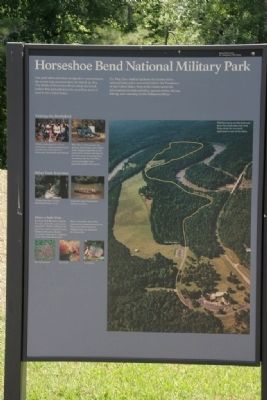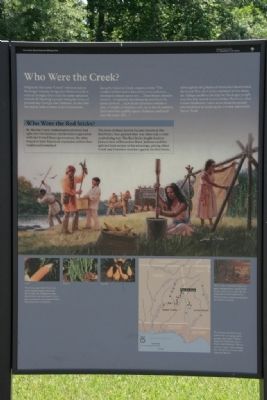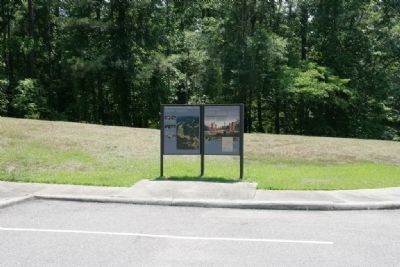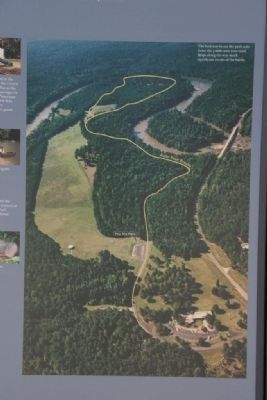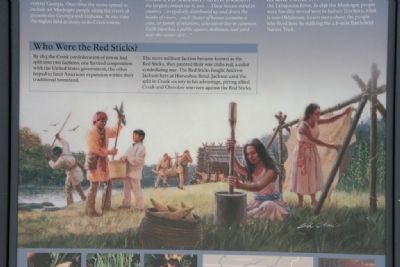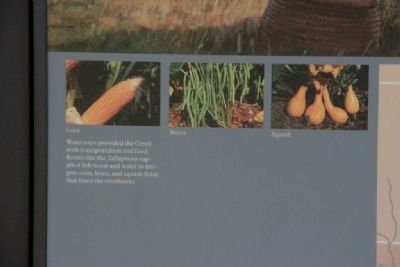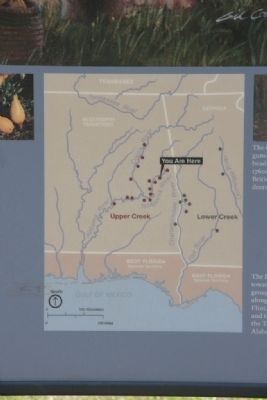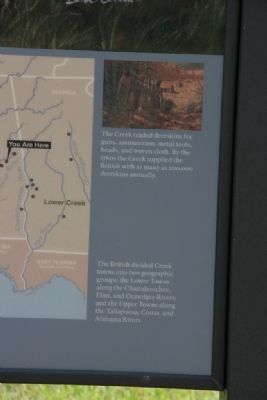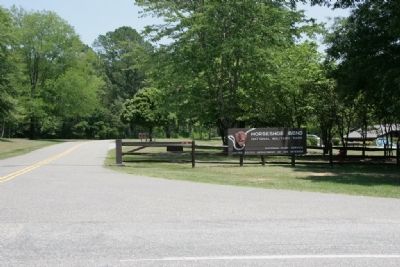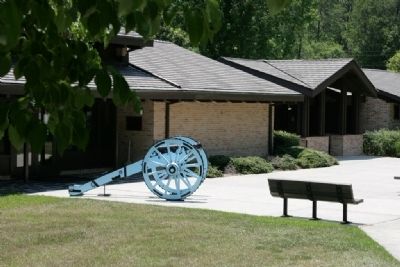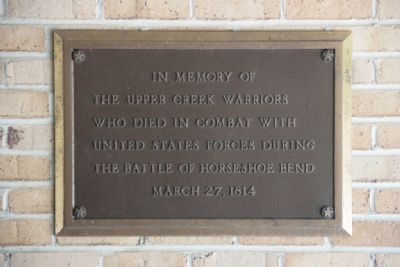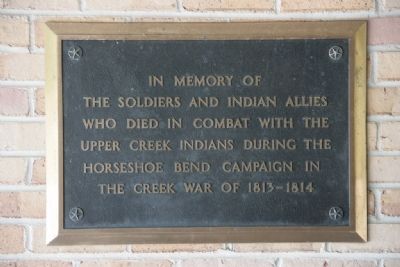Near Daviston in Tallapoosa County, Alabama — The American South (East South Central)
Horseshoe Bend National Military Park
Who Were the Creek?
— National Park Service, U.S. Department of the Interior —
Inscription.
Horseshoe Bend National Military Park
The park offers activities designed to commemorate the events that occurred here on March 27, 1814. The Battle of Horseshoe Bend ended the Creek Indian War and added nearly 23 million acres of land to the United States.
For Maj. Gen. Andrew Jackson the victory led to national fame and a successful bid for the Presidency of the United States. Stop at the visitor center for information on daily activities, special events, hiking, fishing, and canoeing on the Tallapoosa River.
Who Were the Creek?
Originally the name "Creek" referred only to Muskogee Indians living near Ochese Creek in central Georgia. Over time the name spread to include all Muskogee people along the rivers of present-day Georgia and Alabama. At one time the region held as many as 60 Creek towns.
An early visitor to Creek country wrote: "The smallest of their towns have from 20 to 30 houses... the largest contain 150 to 200...These houses stand in clusters...irregularly distributed up and down the banks of rivers...each cluster of houses contains a clan, or family of relations, who eat or live in common. Each town has a public square, hothouse, and yard near the center of it..."
Although the 1814 Battle of Horseshoe Bend ended the Creek War, the Creek continued to live along the Tallapoosa River. In 1836 the Muskogee people were forcibly moved west to Indian Territory, what is now Oklahoma. Learn more about the people who lived here by walking the 2.8-mile Battlefield Nature Trail.
Who Were the Red Sticks?
By 1813 the Creek confederation of towns had split into two factions: one favored cooperation with the United States government, the other hoped to limit American expansion within their traditional homeland.
The more militant faction became known as the Red Sticks, they painted their war clubs red, a color symbolizing war. The Red Sticks fought Andrew Jackson here at Horseshoe Bend. Jackson used the split in Creek society to his advantage, pitting allied Creek and Cherokee warriors against the Red Sticks.
Erected by National Park Service, U.S. Department of the Interior.
Topics and series. This historical marker is listed in these topic lists: Native Americans • Wars, US Indian. In addition, it is included in the Former U.S. Presidents: #07 Andrew Jackson series list. A significant historical date for this entry is March 27, 1814.
Location. 32° 58.812′ N, 85° 44.116′ W. Marker is near Daviston, Alabama, in Tallapoosa County. Marker is on Battlefield Park Tour Road, on the left. Marker is located on the grounds
of Horseshoe Bend National Military Park along the Battlefield Park Road next to the Overlook Stop parking area. Touch for map. Marker is at or near this postal address: 11288 Horseshoe Bend Road, Daviston AL 36256, United States of America. Touch for directions.
Other nearby markers. At least 8 other markers are within walking distance of this marker. A Bloody Contest (about 500 feet away, measured in a direct line); Horseshoe Bend Campaign Combatants (about 800 feet away); Futile Escape (approx. ¼ mile away); Gun Hill (approx. 0.3 miles away); Horseshoe Bend Battleground Monument (approx. 0.3 miles away); Major Lemuel P. Montgomery (approx. 0.3 miles away); Jackson Trace (approx. 0.3 miles away); While the Long Roll Was Beating (approx. 0.4 miles away). Touch for a list and map of all markers in Daviston.
Also see . . .
1. Horseshoe Bend National Military Park. (Submitted on August 19, 2011, by Timothy Carr of Birmingham, Alabama.)
2. Battle of Horseshoe Bend. Encyclopedia of Alabama entry. (Submitted on August 19, 2011, by Timothy Carr of Birmingham, Alabama.)
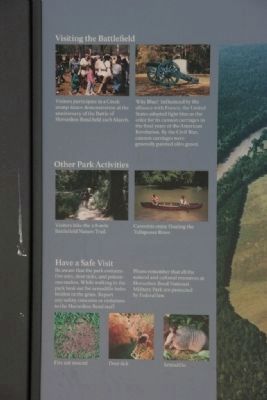
Photographed By TRCP Alliance, June 16, 2011
4. Visiting the Battlefield
Image 1 Top Left: Visitors participate in Creek stomp dance demonstration at the anniversary of the Battle of Horseshoe Bend hold each March.
Image 2 Top Right: Why Blue? Influenced by the alliance with France, the United States adopted light blue as the color for its cannon carriages in the final years of the American Revolution. By the Civil War, cannon carriages were generally painted olive green.
Other Park Activities
Image 3 Middle Left: Visitors hike the 2.8 mile Battlefield Nature Trail.
Image 4 Middle Right: Canoeists enjoy floating the Tallapoosa River.
Have a Safe Visit Be aware that the park contains fire ants, deer ticks, and poisonous snakes. While walking in the park look out for armadillo holes hidden in the grass. Report any safety concerns or violations to the Horseshoe Bend Staff. Please remember that all the natural and cultural resources at Horseshoe Bend National Military Park are protected by Federal law.
Image 5 Bottom Left: Fire ant mound Image 6 Bottom Middle: Deer tick Image 7 Bottom Right: Armadillo
Image 2 Top Right: Why Blue? Influenced by the alliance with France, the United States adopted light blue as the color for its cannon carriages in the final years of the American Revolution. By the Civil War, cannon carriages were generally painted olive green.
Other Park Activities
Image 3 Middle Left: Visitors hike the 2.8 mile Battlefield Nature Trail.
Image 4 Middle Right: Canoeists enjoy floating the Tallapoosa River.
Have a Safe Visit Be aware that the park contains fire ants, deer ticks, and poisonous snakes. While walking in the park look out for armadillo holes hidden in the grass. Report any safety concerns or violations to the Horseshoe Bend Staff. Please remember that all the natural and cultural resources at Horseshoe Bend National Military Park are protected by Federal law.
Image 5 Bottom Left: Fire ant mound Image 6 Bottom Middle: Deer tick Image 7 Bottom Right: Armadillo
Credits. This page was last revised on September 4, 2020. It was originally submitted on August 19, 2011, by Timothy Carr of Birmingham, Alabama. This page has been viewed 1,167 times since then and 30 times this year. Photos: 1, 2, 3, 4, 5, 6, 7, 8, 9, 10, 11, 12, 13. submitted on August 19, 2011, by Timothy Carr of Birmingham, Alabama. • Bill Pfingsten was the editor who published this page.
